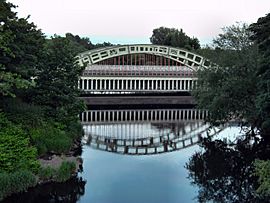Stanley Ferry Aqueduct facts for kids
Quick facts for kids Stanley Ferry Aqueduct |
|
|---|---|
 |
|
| Coordinates | 53°42′09″N 1°27′45″W / 53.7024°N 1.4624°W |
| OS grid reference | |
| Carries | Aire and Calder Navigation |
| Crosses | River Calder |
| Locale | Stanley Ferry |
| Maintained by | Canal & River Trust |
| Heritage status | Grade I listed |
| Characteristics | |
| Trough construction | Cast iron |
| Total length | 165 feet (50.3 m) |
| Width | 24 feet (7.3 m) |
| Towpaths | Both |
| History | |
| Designer | George Leather |
| Construction begin | 1836 |
| Construction end | 1839 |
The Stanley Ferry Aqueduct is a special bridge in West Yorkshire, England. It was built between 1836 and 1839. Its main purpose was to carry the Aire and Calder Navigation canal over the River Calder.
This aqueduct is one of the very first through arch bridges ever built. It's also known for having the longest span made from cast iron for an aqueduct. The bridge was designed by George Leather Sr. and built by H. McIntosh. It is 165 feet (50 m) long, 24 feet (7.3 m) wide, and 8.5 feet (2.6 m) deep.
The original aqueduct is still used today. In 1981, a new, wider concrete aqueduct was built right next to it. After that, the older cast iron bridge was carefully repaired and updated.
Contents
What is an Aqueduct?
An aqueduct is like a bridge that carries water. Instead of cars or trains, it carries a canal or a river over another obstacle, like a valley or another river. The Stanley Ferry Aqueduct helps boats on the canal cross over the River Calder safely.
History of Stanley Ferry
The area around Stanley Ferry has always been important for crossing the River Calder. It was one of three historic fords (shallow places where you could walk or drive across a river) near Wakefield.
As the river was made deeper for boats, people needed a ferry to cross. Later, in 1879, the first bridge was built to replace the ferry.
Tom Pudding Boats
Stanley Ferry was also a busy place for coal transport. From 1863 to 1985, special boats called Tom Pudding tub boats were loaded here. They carried coal from nearby mines. These boats would link together in long trains and travel down the canal to Goole.
Design of the Aqueduct
The Stanley Ferry Aqueduct is a type of bridge called a "through arch bridge." This means the main pathway (the canal channel) goes through the arch of the bridge. The arch itself helps to support the weight.
This bridge is made from cast iron. Cast iron is a very strong material for pushing down, but it can be weak if it's pulled apart. The design of the aqueduct makes sure the strong arch takes all the pushing forces. The ends of the arch push outwards into strong supports called abutments on either side of the river.
Images for kids


